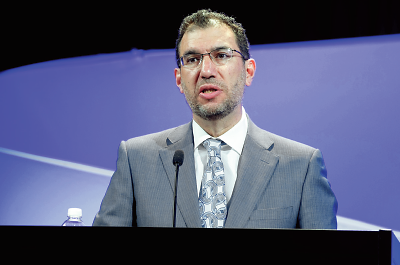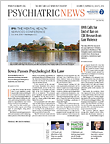The federal government wants to start listening—really listening—to physician concerns, said Centers for Medicare and Medicaid Services (CMS) Administrator Andy Slavitt to the AMA House of Delegates last month.
In an address on the opening day of the House of Delegates meeting in Chicago, Slavitt sought to persuade physicians that the government is determined to reverse a pattern of top-down administration of rules and regulations for Medicare payment by listening to physician concerns and incorporating them into ongoing program improvement and refinement.
“I’m here to talk about reversing a pattern of regulations and frustration and ultimately unleashing a new wave of collaboration between the people who spend their lives taking care of us and those of us whose job it is to support that cause,” he said.
Slavitt reviewed the passage of the Medicare Access and CHIP Reauthorization Act (MACRA), which crucially ended the sustainable growth rate component of the Medicare payment formula and created a new value-based payment system known as the Merit-Based Incentive Payment System (MIPS). MACRA also consolidated already existing quality improvement programs at CMS and reduced the number of quality reporting measures necessary.
On April 27 CMS released the highly anticipated proposed rule to establish key parameters for the new Quality Payment Program, a framework that includes the MIPS and Alternative Payment Models. APA has delivered comments to CMS in response to the proposed rule; a final rule is expected to be published in November.
Slavitt acknowledged that “with MACRA, we answered one question and opened up a set of others that are now ours to begin to address.”
He said the key question to address is how to make the new quality payment system work so that physicians can focus on treating patients while also helping to keep the Medicare program solvent into the future.
“As the Medicare program moves into its golden years, so does the reality of the job it must do in caring for our nation’s elderly and disabled,” he said. “There are 10,000 new Medicare beneficiaries every day, a boom generation is turning 70, and the 85 and up generation is set to double over the next 10 years. With the growth of Medicare beneficiaries outpacing the growth of working Americans, we need to find ways, like we do in other sectors, to deliver better care at lower costs.”
Slavitt emphasized three important, overarching changes to physician payment under MACRA. The first is that it sunsets three previous programs that had overlapping (and sometimes conflicting) requirements—the Physician Quality Reporting System, the Value Modifier, and the Meaningful Use Program—and replaces them with a single, aligned Quality Payment Program. Slavitt said the Quality Reporting System, which incorporates MIPS to pay physicians, will “reduce reporting requirements, eliminate duplication, and reduce the number of measures. For those who participate in Alternative Payment Models, those requirements are reduced further or eliminated.”
Second, Slavitt said, MACRA reduces the combined possible downward adjustment of 9 percent that is occurring now from the three programs to a maximum of 4 percent in the first year of the Quality Payment Program. “The program is designed to build up over the course of several years, with more modest financial impacts in the first year when the vast majority of physicians are expected to be in the MIPS part of the program,” he said.
Third, while the merit-based incentive portion of the law is designed to be budget neutral in general, there are new opportunities for additional bonuses. “In MIPS, in addition to the 4 percent positive payment adjustment, there is the potential for much higher payments through $500 million in funding over six years,” Slavitt said. “Physicians earn a 5 percent lump-sum bonus for participating in an Advanced Alternative Payment Model.”
Slavitt said that to make the new system work, the administration was determined to do something it hadn’t done well in the past—listen to the needs and concerns of physicians and to their representatives in organized medicine such as AMA and APA.
“Our career staff and our regions have been tasked with connecting us closer and closer to where care actually happens,” he said. “We began this by reaching out and meeting with over 6,300 stakeholders all across the country before we published the proposed rule in April. Our particular focus on meeting with practicing physicians in their offices, in workshops, in focus groups and in weekly sessions to listen to policy options and to dig into the details of how the concepts in MACRA translate into the realities of a busy practice. Since proposing the rule at the end of April, we’ve held over 135 events centered on physicians and clinicians affected by the Quality Payment Program.”
Slavitt seemed to acknowledge that the government had earned physician distrust from a history of making rules and regulations that have tended to make being a physician more difficult.
“We don’t win back hearts and minds with empty promises of quick fixes,” Slavitt said. “We win them back by listening, by making progress even in small steps, and by calling attention to where the system remains dysfunctional. We don’t have the option of running from these challenges because they at the very heart of the care we get, that our family gets, that our country gets.”
Slavitt outlined four priorities to govern progress going forward:
•
Keeping the patient at the center care. “In all my years, I have never met a physician who makes her decision on how to treat a patient based on how she gets paid,” Slavitt said. “She does what she thinks is right for the patient and hopes that the system will support her. Physicians, and the patients they treat, deserve approaches that support them for doing the right thing, that encourage physicians to collaborate and reduce waste, and keep people at home and in comfortable settings so their lives continue as normally as possible.”
•
Allowing practices to drive how they participate. “We heard directly from many physicians, and specialists in particular, that a one-size-fits-all program won’t work,” he said. “That’s why we are aiming to build a program that will be as flexible as possible so physicians can focus first, on what’s right for their patients or makes sense in their local community and choose from a number of ways to participate in the Quality Payment Program. That means more options on choosing appropriate measures. Options on whether to participate in models like ACOs and Medical Homes and the flexibility to move between them without having to report multiple times. It also means using quality measures selected directly from work with specialty societies.”
•
Focusing on policies based on the needs of small practices and those in rural or underserved areas.
•
Simplifying whenever and wherever possible.
He called on physicians to be patient and to work with the administration in refining the new system.
“I understand the temptation for this program to become a lightning rod for all that’s wrong with the practice of medicine,” he said. “But I ask you that you not make it the case that until every element is perfect, physicians remain cynical and on the sidelines. I promise you that this process and this program will be better with your input and participation, as you help make sure it connects as closely as possible to supporting the realities of patient care. It is essential that physicians not only participate in but have a leading voice in the change that is ahead.” ■

